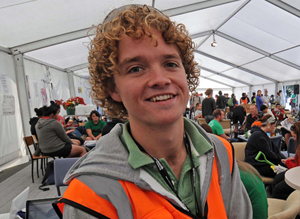The devastating impacts of hurricanes and floodwaters are well known throughout the world, including nearly every region of the United States. In September 2013, a catastrophic amount of flooding besieged Boulder, Colorado, when almost a year’s amount of rain fell in just a few days, killing eight people, stranding thousands, damaging nearly 19,000 homes, and creating miles of impassable roads.
Despite these conditions, volunteers began showing up. In addition to local residents offering to help, thousands arrived from far-off states to help shelter evacuees, clean out flooded homes and buildings, and dig out debris that littered fields and roads for miles. Boulder quickly recognized that in order to rebuild a resilient city, it would need to leverage all of its resources wisely – including the talents of residents and others who wished to volunteer.
In this e-Volunteerism feature interview, Beth Steinhorn, president of VQ Volunteer Strategies, begins with a first-person account of the city's initial response to the floods. She then conducts an important interview with Aimee Kane, Boulder's Volunteer Program and Project Manager, who discusses why and how the City of Boulder built a culture of community and volunteer engagement in the years since the floodwaters of 2013.




 Australia has seen its share of natural disasters – most notably bushfires and floods – and the surge of spontaneous volunteering each emergency produces. While recent attempts to register volunteers in advance of a disaster are useful, too few are actually activated during an emergency because local officials do not have the resources or skills to coordinate them. In the spring of 2012, with the annual bushfire season right around the corner, Volunteering Victoria, the peak volunteering body for the State of Victoria in Australia, had a simple idea: Why not create a platform that links volunteer program managers across the state in times of emergency?
Australia has seen its share of natural disasters – most notably bushfires and floods – and the surge of spontaneous volunteering each emergency produces. While recent attempts to register volunteers in advance of a disaster are useful, too few are actually activated during an emergency because local officials do not have the resources or skills to coordinate them. In the spring of 2012, with the annual bushfire season right around the corner, Volunteering Victoria, the peak volunteering body for the State of Victoria in Australia, had a simple idea: Why not create a platform that links volunteer program managers across the state in times of emergency? When massive earthquakes hit Christchurch, New Zealand in February 2011, university students wanted to help in the clean-up. But established first response agencies were wary of these young volunteers and too harried to work with them, so they turned them away. Sam Johnson, a student leader, would not take "no" for an answer. He turned to Facebook and put out a call to his friends. Within hours, Johnson had recruited a team of workers and borrowed enough loaned equipment to go out and simply start “mucking out.” Over the next several days, as his social network spread the word, hundreds and then thousands of students stepped forward. They called themselves the Student Volunteer Army (SVA) and eventually numbered 9,000 volunteers, earning the respect and support of the local authorities along the way. The story of Johnson and the Student Volunteer Army eventually drew headlines around the world, and attracted the attention and praise of everyone from Prince William of England to Secretary of State Hillary Clinton of the United States. Because of the media attention SVA received, the student volunteers were invited to Japan after the tsunami hit to work with a like-minded team of students. And Johnson recently returned from the World Summit for Youth Volunteering in Colombia, South America, where he presented on the role of Youth in Disaster.
When massive earthquakes hit Christchurch, New Zealand in February 2011, university students wanted to help in the clean-up. But established first response agencies were wary of these young volunteers and too harried to work with them, so they turned them away. Sam Johnson, a student leader, would not take "no" for an answer. He turned to Facebook and put out a call to his friends. Within hours, Johnson had recruited a team of workers and borrowed enough loaned equipment to go out and simply start “mucking out.” Over the next several days, as his social network spread the word, hundreds and then thousands of students stepped forward. They called themselves the Student Volunteer Army (SVA) and eventually numbered 9,000 volunteers, earning the respect and support of the local authorities along the way. The story of Johnson and the Student Volunteer Army eventually drew headlines around the world, and attracted the attention and praise of everyone from Prince William of England to Secretary of State Hillary Clinton of the United States. Because of the media attention SVA received, the student volunteers were invited to Japan after the tsunami hit to work with a like-minded team of students. And Johnson recently returned from the World Summit for Youth Volunteering in Colombia, South America, where he presented on the role of Youth in Disaster.